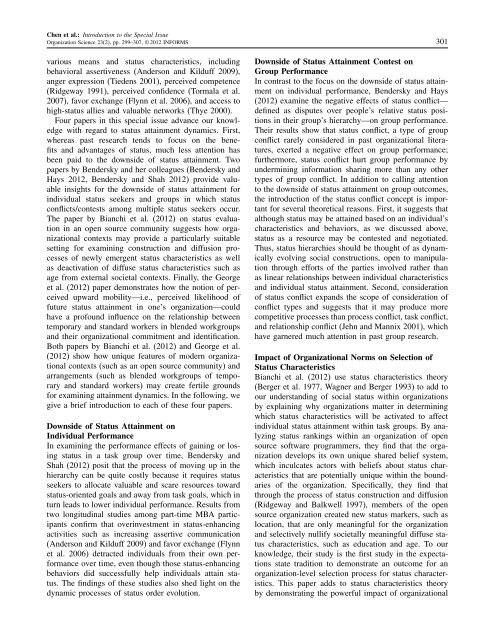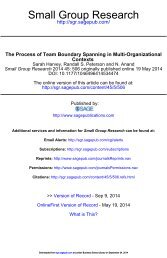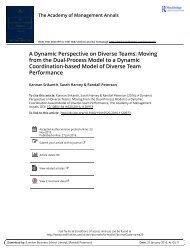Introduction to the Special Issue: Bringing Status to the Table—Attaining, Maintaining, and Experiencing Status in Organizations and Markets
Create successful ePaper yourself
Turn your PDF publications into a flip-book with our unique Google optimized e-Paper software.
Chen et al.: <strong>Introduction</strong> <strong>to</strong> <strong>the</strong> <strong>Special</strong> <strong>Issue</strong><br />
Organization Science 23(2), pp. 299–307, © 2012 INFORMS 301<br />
various means <strong>and</strong> status characteristics, <strong>in</strong>clud<strong>in</strong>g<br />
behavioral assertiveness (Anderson <strong>and</strong> Kilduff 2009),<br />
anger expression (Tiedens 2001), perceived competence<br />
(Ridgeway 1991), perceived confidence (Tormala et al.<br />
2007), favor exchange (Flynn et al. 2006), <strong>and</strong> access <strong>to</strong><br />
high-status allies <strong>and</strong> valuable networks (Thye 2000).<br />
Four papers <strong>in</strong> this special issue advance our knowledge<br />
with regard <strong>to</strong> status atta<strong>in</strong>ment dynamics. First,<br />
whereas past research tends <strong>to</strong> focus on <strong>the</strong> benefits<br />
<strong>and</strong> advantages of status, much less attention has<br />
been paid <strong>to</strong> <strong>the</strong> downside of status atta<strong>in</strong>ment. Two<br />
papers by Bendersky <strong>and</strong> her colleagues (Bendersky <strong>and</strong><br />
Hays 2012, Bendersky <strong>and</strong> Shah 2012) provide valuable<br />
<strong>in</strong>sights for <strong>the</strong> downside of status atta<strong>in</strong>ment for<br />
<strong>in</strong>dividual status seekers <strong>and</strong> groups <strong>in</strong> which status<br />
conflicts/contests among multiple status seekers occur.<br />
The paper by Bianchi et al. (2012) on status evaluation<br />
<strong>in</strong> an open source community suggests how organizational<br />
contexts may provide a particularly suitable<br />
sett<strong>in</strong>g for exam<strong>in</strong><strong>in</strong>g construction <strong>and</strong> diffusion processes<br />
of newly emergent status characteristics as well<br />
as deactivation of diffuse status characteristics such as<br />
age from external societal contexts. F<strong>in</strong>ally, <strong>the</strong> George<br />
et al. (2012) paper demonstrates how <strong>the</strong> notion of perceived<br />
upward mobility—i.e., perceived likelihood of<br />
future status atta<strong>in</strong>ment <strong>in</strong> one’s organization—could<br />
have a profound <strong>in</strong>fluence on <strong>the</strong> relationship between<br />
temporary <strong>and</strong> st<strong>and</strong>ard workers <strong>in</strong> blended workgroups<br />
<strong>and</strong> <strong>the</strong>ir organizational commitment <strong>and</strong> identification.<br />
Both papers by Bianchi et al. (2012) <strong>and</strong> George et al.<br />
(2012) show how unique features of modern organizational<br />
contexts (such as an open source community) <strong>and</strong><br />
arrangements (such as blended workgroups of temporary<br />
<strong>and</strong> st<strong>and</strong>ard workers) may create fertile grounds<br />
for exam<strong>in</strong><strong>in</strong>g atta<strong>in</strong>ment dynamics. In <strong>the</strong> follow<strong>in</strong>g, we<br />
give a brief <strong>in</strong>troduction <strong>to</strong> each of <strong>the</strong>se four papers.<br />
Downside of <strong>Status</strong> Atta<strong>in</strong>ment on<br />
Individual Performance<br />
In exam<strong>in</strong><strong>in</strong>g <strong>the</strong> performance effects of ga<strong>in</strong><strong>in</strong>g or los<strong>in</strong>g<br />
status <strong>in</strong> a task group over time, Bendersky <strong>and</strong><br />
Shah (2012) posit that <strong>the</strong> process of mov<strong>in</strong>g up <strong>in</strong> <strong>the</strong><br />
hierarchy can be quite costly because it requires status<br />
seekers <strong>to</strong> allocate valuable <strong>and</strong> scare resources <strong>to</strong>ward<br />
status-oriented goals <strong>and</strong> away from task goals, which <strong>in</strong><br />
turn leads <strong>to</strong> lower <strong>in</strong>dividual performance. Results from<br />
two longitud<strong>in</strong>al studies among part-time MBA participants<br />
confirm that over<strong>in</strong>vestment <strong>in</strong> status-enhanc<strong>in</strong>g<br />
activities such as <strong>in</strong>creas<strong>in</strong>g assertive communication<br />
(Anderson <strong>and</strong> Kilduff 2009) <strong>and</strong> favor exchange (Flynn<br />
et al. 2006) detracted <strong>in</strong>dividuals from <strong>the</strong>ir own performance<br />
over time, even though those status-enhanc<strong>in</strong>g<br />
behaviors did successfully help <strong>in</strong>dividuals atta<strong>in</strong> status.<br />
The f<strong>in</strong>d<strong>in</strong>gs of <strong>the</strong>se studies also shed light on <strong>the</strong><br />
dynamic processes of status order evolution.<br />
Downside of <strong>Status</strong> Atta<strong>in</strong>ment Contest on<br />
Group Performance<br />
In contrast <strong>to</strong> <strong>the</strong> focus on <strong>the</strong> downside of status atta<strong>in</strong>ment<br />
on <strong>in</strong>dividual performance, Bendersky <strong>and</strong> Hays<br />
(2012) exam<strong>in</strong>e <strong>the</strong> negative effects of status conflict—<br />
def<strong>in</strong>ed as disputes over people’s relative status positions<br />
<strong>in</strong> <strong>the</strong>ir group’s hierarchy—on group performance.<br />
Their results show that status conflict, a type of group<br />
conflict rarely considered <strong>in</strong> past organizational literatures,<br />
exerted a negative effect on group performance;<br />
fur<strong>the</strong>rmore, status conflict hurt group performance by<br />
underm<strong>in</strong><strong>in</strong>g <strong>in</strong>formation shar<strong>in</strong>g more than any o<strong>the</strong>r<br />
types of group conflict. In addition <strong>to</strong> call<strong>in</strong>g attention<br />
<strong>to</strong> <strong>the</strong> downside of status atta<strong>in</strong>ment on group outcomes,<br />
<strong>the</strong> <strong>in</strong>troduction of <strong>the</strong> status conflict concept is important<br />
for several <strong>the</strong>oretical reasons. First, it suggests that<br />
although status may be atta<strong>in</strong>ed based on an <strong>in</strong>dividual’s<br />
characteristics <strong>and</strong> behaviors, as we discussed above,<br />
status as a resource may be contested <strong>and</strong> negotiated.<br />
Thus, status hierarchies should be thought of as dynamically<br />
evolv<strong>in</strong>g social constructions, open <strong>to</strong> manipulation<br />
through efforts of <strong>the</strong> parties <strong>in</strong>volved ra<strong>the</strong>r than<br />
as l<strong>in</strong>ear relationships between <strong>in</strong>dividual characteristics<br />
<strong>and</strong> <strong>in</strong>dividual status atta<strong>in</strong>ment. Second, consideration<br />
of status conflict exp<strong>and</strong>s <strong>the</strong> scope of consideration of<br />
conflict types <strong>and</strong> suggests that it may produce more<br />
competitive processes than process conflict, task conflict,<br />
<strong>and</strong> relationship conflict (Jehn <strong>and</strong> Mannix 2001), which<br />
have garnered much attention <strong>in</strong> past group research.<br />
Impact of Organizational Norms on Selection of<br />
<strong>Status</strong> Characteristics<br />
Bianchi et al. (2012) use status characteristics <strong>the</strong>ory<br />
(Berger et al. 1977, Wagner <strong>and</strong> Berger 1993) <strong>to</strong> add <strong>to</strong><br />
our underst<strong>and</strong><strong>in</strong>g of social status with<strong>in</strong> organizations<br />
by expla<strong>in</strong><strong>in</strong>g why organizations matter <strong>in</strong> determ<strong>in</strong><strong>in</strong>g<br />
which status characteristics will be activated <strong>to</strong> affect<br />
<strong>in</strong>dividual status atta<strong>in</strong>ment with<strong>in</strong> task groups. By analyz<strong>in</strong>g<br />
status rank<strong>in</strong>gs with<strong>in</strong> an organization of open<br />
source software programmers, <strong>the</strong>y f<strong>in</strong>d that <strong>the</strong> organization<br />
develops its own unique shared belief system,<br />
which <strong>in</strong>culcates ac<strong>to</strong>rs with beliefs about status characteristics<br />
that are potentially unique with<strong>in</strong> <strong>the</strong> boundaries<br />
of <strong>the</strong> organization. Specifically, <strong>the</strong>y f<strong>in</strong>d that<br />
through <strong>the</strong> process of status construction <strong>and</strong> diffusion<br />
(Ridgeway <strong>and</strong> Balkwell 1997), members of <strong>the</strong> open<br />
source organization created new status markers, such as<br />
location, that are only mean<strong>in</strong>gful for <strong>the</strong> organization<br />
<strong>and</strong> selectively nullify societally mean<strong>in</strong>gful diffuse status<br />
characteristics, such as education <strong>and</strong> age. To our<br />
knowledge, <strong>the</strong>ir study is <strong>the</strong> first study <strong>in</strong> <strong>the</strong> expectations<br />
state tradition <strong>to</strong> demonstrate an outcome for an<br />
organization-level selection process for status characteristics.<br />
This paper adds <strong>to</strong> status characteristics <strong>the</strong>ory<br />
by demonstrat<strong>in</strong>g <strong>the</strong> powerful impact of organizational
















